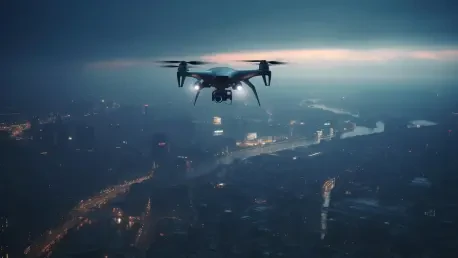In the heart of a bustling American city, a small, buzzing object hovers undetected over a crowded stadium during a major sporting event, posing a serious threat. This is no toy—it’s an unauthorized drone, potentially carrying surveillance equipment or worse, and last year alone, hundreds of such incursions were reported over military bases, airports, and public gatherings, exposing glaring vulnerabilities in U.S. airspace. How can a device costing mere hundreds of dollars pose such a massive risk to national security? This alarming trend has ignited bipartisan concern among state leaders and federal officials, demanding immediate scrutiny and action to safeguard the nation’s skies.
Why Drones Have Become a National Security Nightmare
The sudden rise of drone threats isn’t just a technological quirk; it’s a full-blown crisis that has caught authorities off guard. With sightings of unauthorized drones skyrocketing over sensitive locations, the stakes couldn’t be higher. A single incident can disrupt critical operations, as seen when drones halted airport activities, costing millions in delays. The affordability and anonymity of these devices make them a tool of choice for espionage or chaos, challenging the very fabric of public safety.
This issue transcends party lines, with governors from across the political spectrum joining forces to sound the alarm. Their urgent appeals to Congress highlight a shared fear: without robust defenses, the nation remains exposed to unseen dangers. Federal agencies, too, have flagged drones as a priority threat, noting their potential to bypass traditional security measures with ease.
The core question remains—how can such a small device wield so much power to destabilize? The answer lies in the rapid evolution of technology, outpacing current regulations and countermeasures. This gap has transformed drones from niche gadgets into instruments of risk, setting the stage for a deeper exploration of their impact on U.S. airspace.
The Escalating Danger of Unauthorized Drones in U.S. Airspace
The proliferation of drones has turned what was once a manageable issue into a top-tier national security concern. Available to anyone with a few hundred dollars, these devices are no longer just hobbies for enthusiasts; they’re accessible to those with harmful intent. Reports of drones lingering over nuclear facilities and military installations have sent shockwaves through government circles, revealing how unprepared the system is to handle this modern menace.
Specific incidents paint a grim picture of the potential fallout. Drones have been spotted delivering contraband to prison yards, undermining law enforcement efforts. Even more troubling are cases where they’ve interfered with emergency response operations, such as wildfire fighting, endangering lives and property. These events underscore the urgent need to protect critical infrastructure from aerial intrusions.
Beyond isolated events, the broader implications are chilling. Drones could be weaponized for attacks or used to gather intelligence on sensitive operations, posing risks that ripple across public safety domains. As their numbers grow, so does the necessity for a coordinated response to reclaim control over the nation’s skies.
Dissecting the Drone Threat: Technology, Misuse, and Weaknesses
At the heart of the drone crisis lies the remarkable advancement of the technology itself. Drones have evolved into sophisticated tools, equipped with high-definition cameras and extended flight ranges, all while remaining affordable. Ryan Wallace, a professor at Embry-Riddle Aeronautical University, notes that this accessibility acts as a “disproportionate force multiplier,” enabling anyone to conduct aerial operations that were once the domain of elite entities.
Misuse of drones further compounds the problem, with documented cases revealing their dark potential. From smuggling drugs across borders to conducting unauthorized surveillance over military zones, the patterns of abuse are diverse and alarming. One notable instance involved a drone harassing attendees at a public event, illustrating how even non-lethal uses can sow panic and disruption.
Current airspace security also reveals critical vulnerabilities, with statistics from a bipartisan governors’ letter showing hundreds of incursions over restricted sites annually. Detection systems often lag behind drone capabilities, leaving gaps that bad actors exploit. These weaknesses highlight the multi-dimensional nature of the threat, demanding solutions that address both technological and regulatory shortcomings.
Expert Perspectives and Stark Warnings on Drone Risks
Voices from academia and government are uniting to emphasize the gravity of unauthorized drone activity. Catherine F. Cahill, a researcher at the University of Alaska Fairbanks, warns against physical interception methods, citing dangers like falling debris or misidentification of aircraft. Her caution against vigilante actions underscores the complexity of enforcing drone laws safely.
Congressional hearings have amplified these concerns, with testimonies urging swift legislative action to empower local authorities. A striking anecdote from a recent hearing described a drone incursion that forced the temporary closure of a major public venue, grounding activities and alarming thousands. Such real-world disruptions make the threat feel immediate and personal to everyday citizens.
The bipartisan letter from 31 governors to Congress further cements the urgency, pleading for federal resources to bolster state defenses. Their collective stance reflects a rare consensus: drone threats are not a distant possibility but a present danger requiring unified effort. These insights from experts and leaders ground the issue in tangible consequences, pushing for change now.
Tackling the Drone Crisis: Strategies and Future Actions
Addressing the drone epidemic requires a blend of policy reform and innovation to close existing gaps. Legislative efforts must prioritize clear counter-UAS laws, granting state and local officials explicit authority to act. Louisiana’s recent law, enacted this year, serves as a potential blueprint, allowing law enforcement to intercept threatening drones under defined conditions, a model that could inspire national frameworks.
Technological advancements offer another vital avenue, with counter-drone systems designed to neutralize threats without physical destruction gaining traction. Federal funding and partnerships with private firms, such as D-Fend Solutions, are essential to scale these tools. Investments in detection and mitigation tech can provide non-lethal options, reducing risks associated with kinetic responses.
Collaboration remains key, with expanded pilot programs for law enforcement and cross-agency data sharing critical to success. Public awareness campaigns can also deter reckless drone use by educating operators on legal boundaries. These actionable steps, tailored to the unique challenges of drone threats, pave the way for a safer airspace, ensuring that responses match the scale of the crisis.
Reflecting on the Path Forward
Looking back, the mounting drone incursions over sensitive U.S. sites revealed a nation grappling with an invisible yet pervasive threat. Each incident, from stadium flyovers to military base breaches, exposed a critical need for readiness that had yet to be met. The bipartisan urgency and expert warnings echoed a unified call for stronger defenses against these aerial risks.
Moving ahead, actionable solutions emerged as the cornerstone of progress. Comprehensive legislation needed to empower local authorities, while investments in counter-drone technology promised safer interventions. Collaborative efforts across government levels and with private innovators held the potential to reshape airspace security. As these strategies took root, the hope was to transform vulnerability into resilience, ensuring that the skies above remained a shield, not a liability, for future generations.









